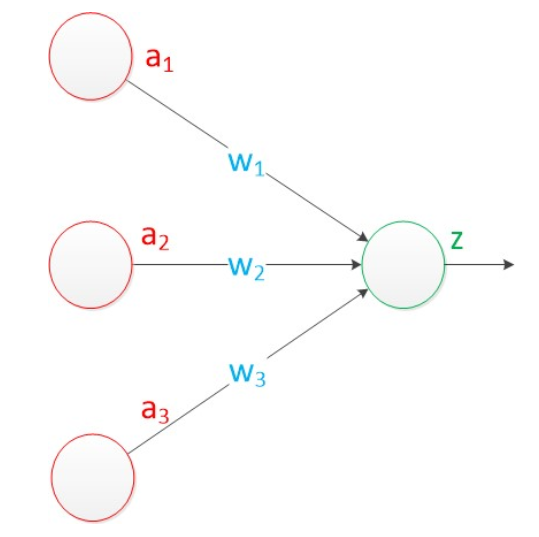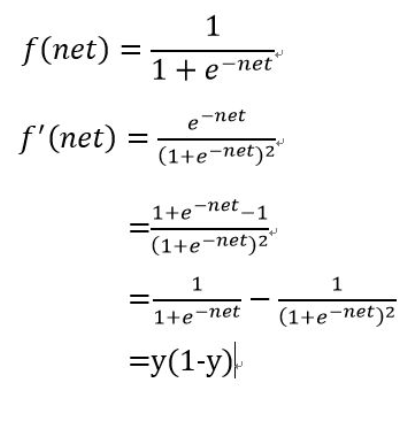本文實例為大家分享了Python實現(xiàn)感知器模型、兩層神經(jīng)網(wǎng)絡(luò),供大家參考,具體內(nèi)容如下
python 3.4 因為使用了 numpy
這里我們首先實現(xiàn)一個感知器模型來實現(xiàn)下面的對應(yīng)關(guān)系
[[0,0,1], ——- 0
[0,1,1], ——- 1
[1,0,1], ——- 0
[1,1,1]] ——- 1
從上面的數(shù)據(jù)可以看出:輸入是三通道,輸出是單通道。

這里的激活函數(shù)我們使用 sigmoid 函數(shù) f(x)=1/(1+exp(-x))
其導(dǎo)數(shù)推導(dǎo)如下所示:

L0=W*X;
z=f(L0);
error=y-z;
delta =error * f'(L0) * X;
W=W+delta;
python 代碼如下:
|
1
2
3
4
5
6
7
8
9
10
11
12
13
14
15
16
17
18
19
20
21
22
23
24
25
26
27
28
29
30
31
32
33
34
35
36
37
38
39
40
41
42
43
44
45
46
|
import numpy as np#sigmoid functiondef nonlin(x, deriv = False): if(deriv==True): return x*(1-x) return 1/(1+np.exp(-x))# input datasetX=np.array([[0,0,1], [0,1,1], [1,0,1], [1,1,1]])# output datasety=np.array([[0,1,0,1]]).T#seed( ) 用于指定隨機數(shù)生成時所用算法開始的整數(shù)值,#如果使用相同的seed( )值,則每次生成的隨即數(shù)都相同,#如果不設(shè)置這個值,則系統(tǒng)根據(jù)時間來自己選擇這個值,#此時每次生成的隨機數(shù)因時間差異而不同。np.random.seed(1) # init weight value with mean 0syn0 = 2*np.random.random((3,1))-1 for iter in range(1000): # forward propagation L0=X L1=nonlin(np.dot(L0,syn0)) # error L1_error=y-L1 L1_delta = L1_error*nonlin(L1,True) # updata weight syn0+=np.dot(L0.T,L1_delta)print("Output After Training:")print(L1) |
從輸出結(jié)果可以看出基本實現(xiàn)了對應(yīng)關(guān)系。
下面再用兩層網(wǎng)絡(luò)來實現(xiàn)上面的任務(wù),這里加了一個隱層,隱層包含4個神經(jīng)元。
|
1
2
3
4
5
6
7
8
9
10
11
12
13
14
15
16
17
18
19
20
21
22
23
24
25
26
27
28
29
30
31
32
33
34
35
36
37
38
39
40
41
42
43
44
45
46
47
48
49
50
|
import numpy as npdef nonlin(x, deriv = False): if(deriv == True): return x*(1-x) else: return 1/(1+np.exp(-x))#input datasetX = np.array([[0,0,1], [0,1,1], [1,0,1], [1,1,1]])#output datasety = np.array([[0,1,1,0]]).T#the first-hidden layer weight valuesyn0 = 2*np.random.random((3,4)) - 1#the hidden-output layer weight valuesyn1 = 2*np.random.random((4,1)) - 1for j in range(60000): l0 = X #the first layer,and the input layer l1 = nonlin(np.dot(l0,syn0)) #the second layer,and the hidden layer l2 = nonlin(np.dot(l1,syn1)) #the third layer,and the output layer l2_error = y-l2 #the hidden-output layer error if(j%10000) == 0: print "Error:"+str(np.mean(l2_error)) l2_delta = l2_error*nonlin(l2,deriv = True) l1_error = l2_delta.dot(syn1.T) #the first-hidden layer error l1_delta = l1_error*nonlin(l1,deriv = True) syn1 += l1.T.dot(l2_delta) syn0 += l0.T.dot(l1_delta)print "outout after Training:"print l2 |
以上就是本文的全部內(nèi)容,希望對大家的學(xué)習(xí)有所幫助,也希望大家多多支持服務(wù)器之家。
原文鏈接:http://blog.csdn.net/zhangjunhit/article/details/53487109










